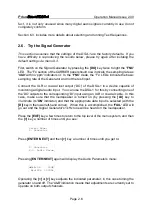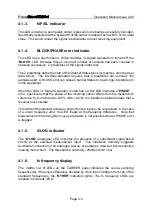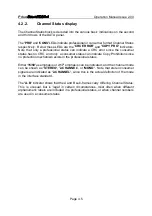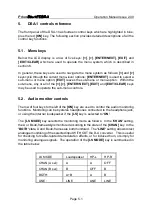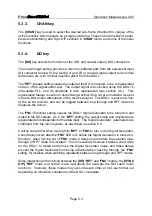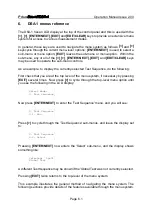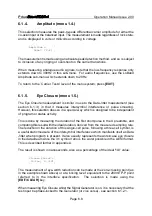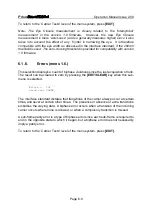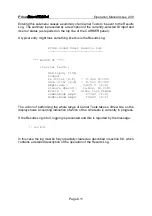
Prism
Operation Manual Issue 2.00
Page 5.1
5.
DSA-1 controls reference
The front panel of the DSA-1 has fourteen control keys which are highlighted in blue,
plus the red [ON] key. The following section provides detailed descriptions of all the
control key functions.
5.1. Menu keys
Below the LCD display is a row of five keys: [<], [>], [ENTER/NEXT], [EXIT] and
[EDIT/CLEAR] which are used to operate the menu system, which is described in
section 6.
In general, these keys are used to navigate the menu system as follows: [<] and [>]
keys cycle through the current menu-level options; [ENTER/NEXT] is used to select a
sub-menu or menu option; [EXIT] leaves the sub-menu or menu-option. Within the
sub-menu, any or all of the [<], [>], [ENTER/NEXT], [EXIT] and [EDIT/CLEAR] keys
may be used to operate the sub-menu controls.
5.2. Audio monitor controls
The row of four keys to the left of the [ON] key are used to control the audio monitoring
functions. Monitoring can be by stereo headphones connected to the headphone jack,
or using the internal loudspeaker if the [LS] key is selected to 'ON'.
The [LS MODE] key selects the monitoring mode as follows: In the 'CHAN' setting,
the A or B sub-frame only is monitored according to the state of the [CHAN] key. In the
'BOTH' state, A and B sub-frames are both monitored. The 'LINE' setting allows direct
analogue monitoring of the selected input WITHOUT the D-A converter. This is useful
for checking for cable-related demodulation effects, or for induced hum, or simply for
monitoring analogue signals. The operation of the [LS MODE] key is summarised in
the table below:
LS MODE
Loudspeaker
HP-L
HP-R
CHAN (A sel):
A
A
OFF
CHAN (B sel):
B
OFF
B
BOTH:
A+B
A
B
LINE:
LINE
LINE
LINE


